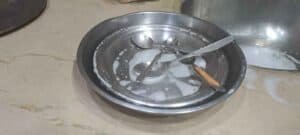Is the sight of water stains on your dishes driving you up the wall? Worry no more! Leveraging my insights, I offer a foolproof roadmap to Say Goodbye To Hard Water Stains On Your Utensils Forever. With time-tested strategies in my arsenal, you’re a step away from flaunting impeccable, gleaming knives.
“After deep dives into research and various trials, I’ve cracked the code on erasing those water marks caused by mineral deposits on your kitchenware. By embracing my suggested approaches, a radiant kitchen awaits you.”
In this piece, I’ll unveil household ingredients that breathe new life into your kitchen equipment. It’s time to usher out those obstinate spots and usher in a flawless kitchen!

What’s behind those watermarks on your kitchenware?
At the core of this nuisance is the mineral-laden character of hard water, which, over time, deposits residues on our kitchen items. If unchecked, these minerals can even damage and discoloration of our favorite cookware.
Impact of Hard Water Marks on Stainless Steel Dishes
- Surface Dulling: Mineral-rich water can make surfaces lose their sheen.
- Tinge: Mineral deposits might lead to unsightly spots, marring the look.
- Accumulation: Over time, mineral build-up complicates the cleaning regimen.
- Deterioration: Exposure to mineral-heavy water can compromise the integrity of utensils.
- Odd Odors: Such waters might impart a peculiar scent, which isn’t exactly appetizing.
How to remove hard water stains from Utensils?
With a dash of determination, ridding your utensils of watermarks is a breeze! One tried-and-tested approach involves immersing your utensils in vinegar for several hours. A gentle scrub later, and behold – your dishes are as good as new.
White Vinegar Solution
A 50-50 mix of water and white vinegar comes to the rescue for those adamant watermarks. Give the affected area a scrub, rest for about 10 minutes, then wipe it away with a cloth. For tenacious spots, let it act longer – possibly overnight.
Baking Soda Mix
Baking soda, in its gritty form, can aid in tackling persistent water stains. Create a thick paste mixing water and baking soda, apply it, and let it do its magic for about an hour. A gentle rub and those marks will be history.
Vinegar Meets Baking Soda
A paste of baking soda, white vinegar, and warm water can be applied to the spots for more robust action. An hour-long wait and a gentle rub later, your kitchenware will gleam.
Store-bought Solutions
If home remedies don’t cut it, market-available products like CLR and Lime-A-Way can be sought. These powerful concoctions can dissolve stubborn mineral residues. However, always follow directions and wear gloves.
Lemon or Vinegar for the Win
The acidic traits of lemon or vinegar are excellent for dislodging mineral deposits. Dab some onto the stain, scrub lightly, and watch those marks disappear. For resilient spots, let it act longer before cleaning.

Safeguarding Dishes from Water Marks
- Consider a Water Softening Unit: Such devices can substantially reduce mineral content, safeguarding your utensils.
- Gentle Brushes for the Win: Opt for soft brushes to fend off water spots.
- Protective Coatings: Applying protective layers on surfaces can minimize water stain occurrences.
- Steer Clear of Forceful Water Jets: High-pressure jets can induce water spots. Low pressure is the way to go.
- Stay Vigilant: Frequently inspect surfaces for early signs of water spots, nipping them in the bud using gentle cleansers.
Avoid These for Water Marks Removal
- Scratch-inducing materials – they can exacerbate corrosion on stainless steel.
- Chlorine-based bleaches – apart from being detrimental to utensils, they’re not environmentally friendly.
- Steel brushes can strip away the protective layers of stainless steel, increasing vulnerability.
- Aggressive chemicals might erode protective coatings and can be harmful when ingested.
The insights shared will ensure your stainless-steel dishes remain impeccable and promote safe cleaning without resorting to harmful chemicals.
Final Thoughts
Battling hard water stains on stainless steel isn’t Herculean. Armed with the above remedies, especially vinegar and baking soda concoctions, you can rejuvenate your kitchenware with minimal fuss.
